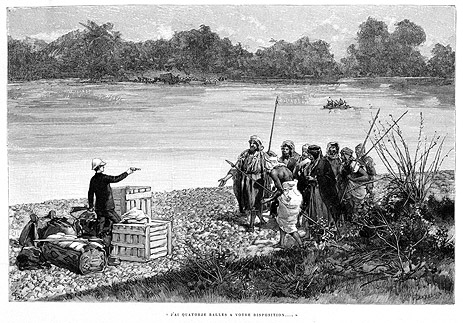Image Resource Bank
Image Gallery |  10 of 15
10 of 15 
“I Have Fourteen Bullets at Your Disposal”
By the late 1880s, British, French, German, and American archaeological expeditions were excavating ancient Assyrian, Babylonian, and Sumerian sites in the Mesopotamian provinces of the Ottoman Empire, as well as Achaemenid Persian and pre-Iranian Elamite sites in the Qajar kingdom of Iran. None of these territories was under the control of the European imperial powers, but the development of archaeology played out in the shadow of the imperial competition for spheres of political, economic, and cultural influence.
The site of Susa, in southwestern Iran, had been probed by the English traveler William Kennett Loftus in the 1850s, but the first major excavations there began with the French explorers Marcel and Jane Dieulafoy in the 1880s. This was the first phase of what was to become the longest continuous major excavation of an ancient Near Eastern city site, lasting with occasional interruptions until 1979.
To European and American audiences, these early archaeological expeditions were adventures in exotic, wild, sometimes lawless circumstances. Jane Dieulafoy added another dimension of adventure, as a woman who dressed like a man and took the risks and roles of men in a world of masculine work, masculine threat, and masculine social domination. Here she displays the arrogance and bravery with which accounts of adventure and discovery instructed the boys who were to be the leaders of the future. Separated from the rest of her party who crossed the river ahead of her, and confronted with the possibility of menace from a group of Bedouins armed with spears and daggers, Jane coolly levels her revolver with the words “I have fourteen bullets at your disposal. Go find six of your friends.”
By the late 1880s, the Ottoman rulers had established a European-style museum in Istanbul to display some of the antiquities found throughout their empire, but almost everything that the European and American excavations discovered was taken back to the sponsoring countries until the 1920s, when national museums of the same kind were set up in Baghdad, Tehran, and elsewhere. These institutions showed the results of mostly European exploration as narratives of national histories of Middle Eastern states, whether established kingdoms like Iran or newly created states like Iraq or Turkey.
Name: “I Have Fourteen Bullets at Your Disposal”
Material: Paper, ink
Size:
Width: 24 cm (9.45 in)
Height: 16 cm (6.3 in)
Date: 1888 CE
Place of Origin: A Suse: Journal des Fouilles, Jane Dieulafoy
Location: A Suse: Journal des Fouilles, Jane Dieulafoy
Source and Registration#: A Suse: Journal des Fouilles, Jane Dieulafoy

 Matthew W. Stolper
Matthew W. Stolper
Professor of Assyriology and the John A. Wilson Professor of Oriental Studies




